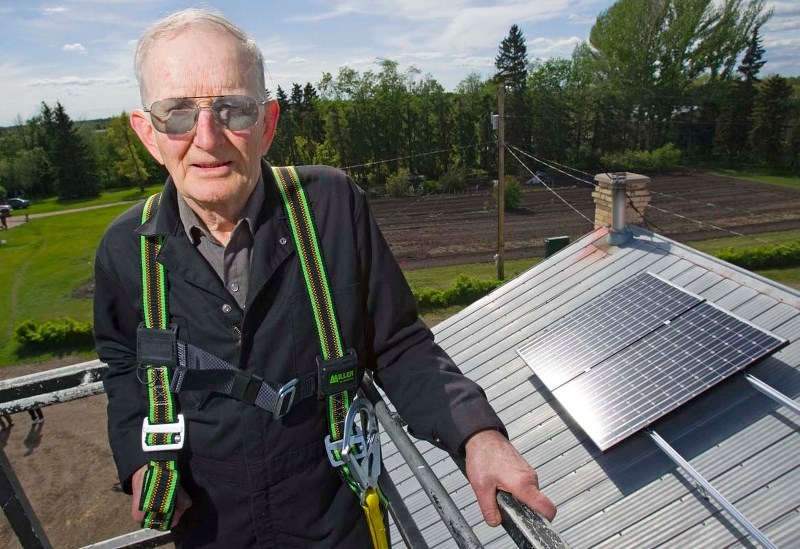John Bocock is an old hand at solar power, having used it for the last 80-odd years as a farmer.
But it wasn't until 2010 that he started tapping the sun for electricity by putting a row of solar panels on his roof. While he did it as a way to protest the Heartland transmission project (more local power means less need for big power lines, he reasoned), he says it's also a way for him to reduce his carbon footprint.
Bocock says he knows that the panels send DC power down a wire to a converter into his house, but is a little fuzzy on how they turn light into electricity.
"I'm just an old farmer," he says.
The photoelectric effect
The solar panels on homes, cars, satellites and calculators all work because of the photoelectric effect, says Gordon Howell, an electrical engineer with the Solar Energy Society of Alberta who's worked with the solar technology for 35 years.
French scientist Edmund Becquerel discovered the photoelectric effect in 1839 when he noticed that some metals generated electricity when exposed to light, but it wasn't until 1905 that Albert Einstein actually explained it, winning him the Nobel Prize.
The effect relates to the nature of electrons, Howell explains. Electrons orbit atoms at specific energy levels and cannot exist between these levels – they either have exactly enough energy to change levels or they don't. There are also only a set number of electrons that fit in each level.
Atoms want to fill their outermost (or valence) electron level and will combine with other atoms to do so. Conductors, such as copper, have lots of space in their valence levels and exchange electrons easily. Semi-conductors like silicon have less space and need an extra kick to do so.
When light hits a semi-conductor like silicon, some of it supercharges electrons in its atoms, causing them to fly free, leaving behind positive "holes" in their home atoms. Normally, the electron simply falls into another hole, but if it hits a wire made out of a conductor, it can be whisked away to create electricity before looping back.
"Electricity is merely free electrons," Howell notes.
Silicon is pretty lousy at doing this on its own, so researchers stack the deck by "doping" slabs of silicon with impurities that have one more or one less electron in their outer levels than silicon – typically boron (one less) or phosphorous (one more) – and slapping them together to form solar cells.
When you put these doped slabs together, the extra electrons from the phosphorous side make a mad dash to fill the extra holes on the boron side. They fill the holes at the junction between the slabs, creating an electric field that stops all the extra electrons from flowing over.
Bring in the sun, and you get a whole bunch more free electrons that want to cross to the positive slab, but can't due to the field. Add a wire, and they'll hop aboard and zip around.
Why silicon sucks
Silicon solar panels are only about 16 per cent efficient, Howell says: not only do some of their freed electrons fill holes before they reach a wire, but a lot of the light also misses the electrons – much of an atom is empty space.
Silicon is also really picky when it comes to what kind of light it needs before it creates electricity, adds Karen Hinzer, a professor of electrical engineering at the University of Ottawa who studies solar technology.
"Silicon is actually not a very good absorber of light," she says.
While silicon absorbs most of the visible spectrum, only photons with a wavelength of 1.1 microns carry the precise amount of energy needed to cause silicon's electrons to fly free – everything else just becomes heat.
Hinzer is working on solar panels made from other semi-conductors such as cadmium telluride that absorb other wavelengths. By stacking many different semi-conductors on top of each other, she's managed to make panels that are 45 per cent efficient.
There's also tonnes of research going into improving other parts of solar panels, Howell notes: better glass that reflects less light, for example, or thinner wires that shade less silicon.
But solar panels work well enough that you can power an Edmonton home on a net basis with 24 of them, Howell says.
"Solar electricity is the lowest cost electricity option for homeowners in Alberta today without any government subsidy," he says – it costs about one cent per kilowatt hour, compared to about 18 for coal. (The panels take 20 years to pay for themselves, though.)
It's a technology Bocock says people should use.
"I don't know if you've checked your rain gauge recently, but mine hasn't overflowed for quite some time," he says.
"We're running out of water, and climate change is not helping that. We need to change the way we operate otherwise we're going to be in serious trouble."
Scientific St. Albert
Like science? So do we! Scientific St. Albert looks at a simple, common phenomenon in the St. Albert region and explains it with the help of local scientists every other week.
Got a burning scientific question? Send it in to [email protected].




